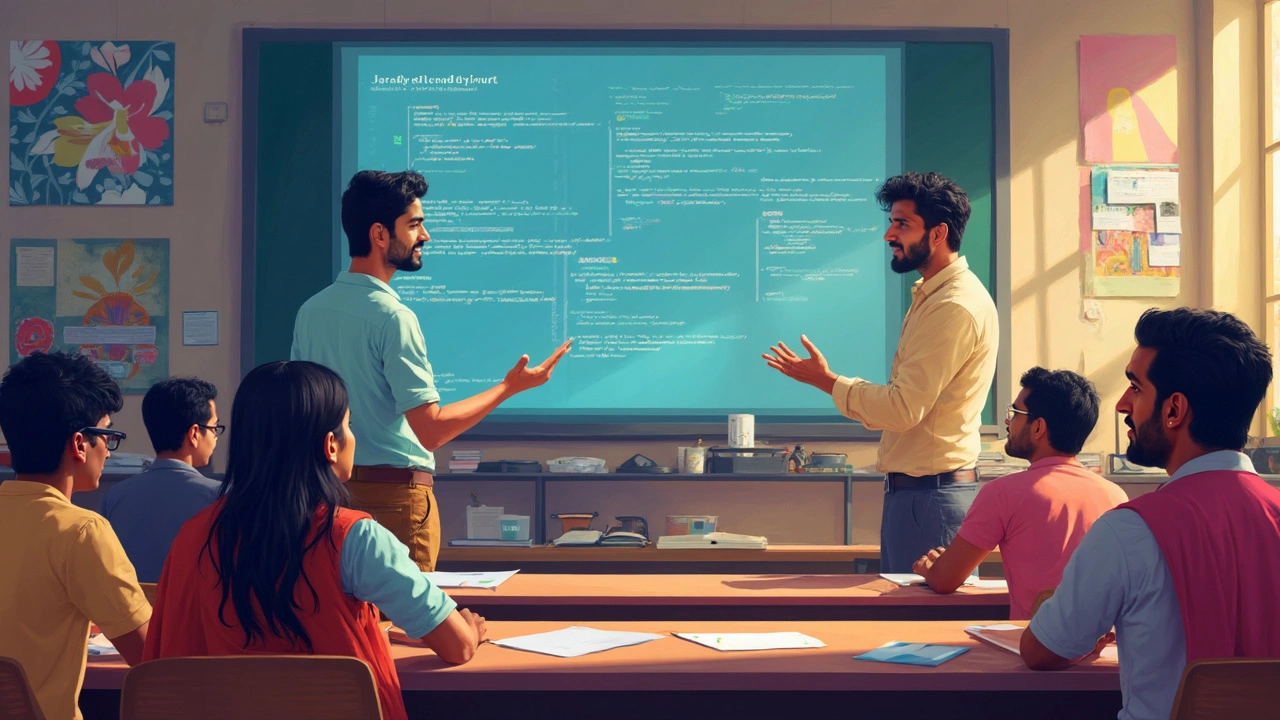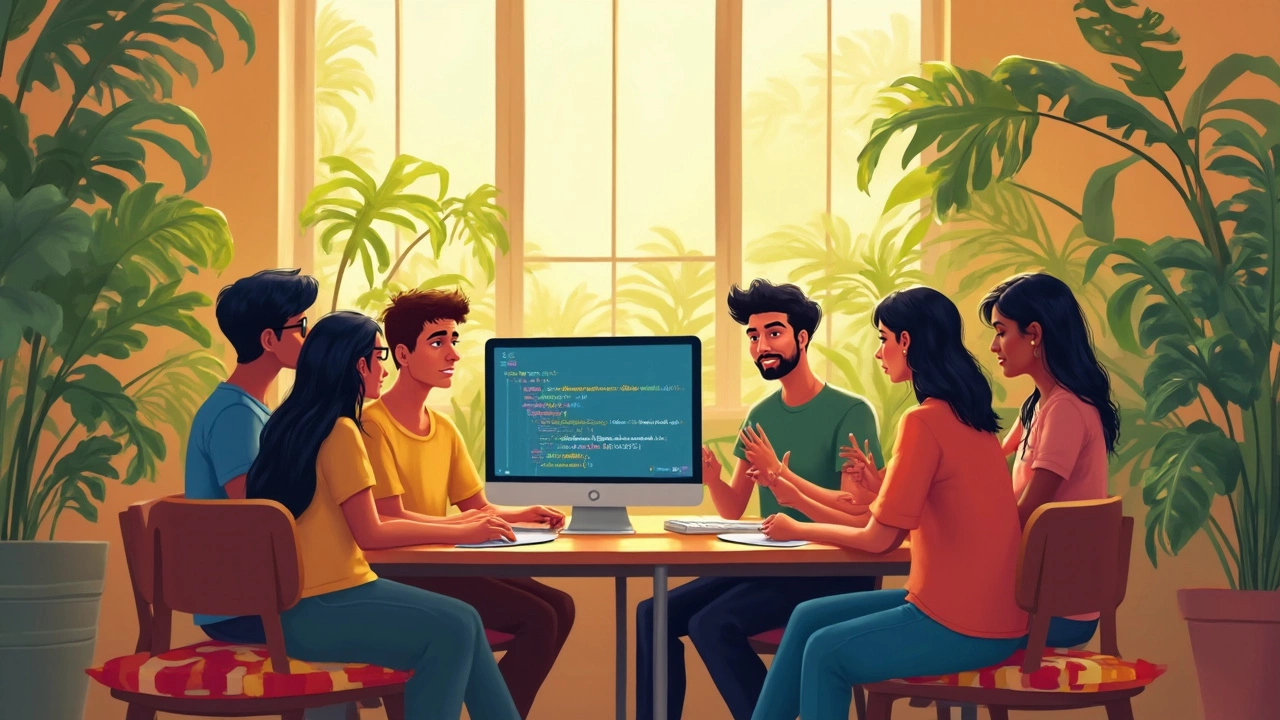If you've ever thought about diving into programming, you've probably heard a lot about Python. Is it really the golden ticket for beginners? Well, Python's got this cool reputation for being super accessible. It's like the gentle giant of programming languages, especially when you're just starting out. Ever wondered why?
Picture this: you're writing code, and instead of scratching your head over endless brackets or semicolons, Python lets you focus on the logic and creativity. Its syntax feels almost like writing in plain English. This simplicity is one of the reasons Python's often recommended as a great first language.
On top of that, Python is everywhere! From web development to data science, even the apps your phone runs on might be using it. And the best part? There's a ton of resources out there. Whether you're a video person or you love reading, there's something for every learning style. Plus, with communities full of happy-to-help coders, you're never really alone on this journey. So, curious to see what makes Python tick? Keep reading!
- Why Python is Beginner-Friendly
- Key Features of Python
- Common Challenges and Solutions
- Tips for Learning Python Efficiently
- How Python Opens Career Opportunities
Why Python is Beginner-Friendly
You've probably heard that Python is one of the easiest programming languages to learn, and for good reason. One of the biggest advantages of Python—and why it's loved by newbies—is its simple, readable syntax. Imagine writing code that almost reads like regular English. This lowers the barrier of entry for those new to coding classes and programming in general. You can focus on problem-solving instead of getting bogged down with strict syntax rules.
Another cool thing about Python is its community. If you run into a problem, there's a good chance someone else has faced it too, and you'll find solutions all over the internet. Plus, there are tons of free resources, tutorials, and forums where you can learn and ask questions. When you're starting out, having access to a supportive community really helps keep you motivated.
Python is also versatile. Whether you're interested in web development, game development, or data science, Python's got you covered. It’s like the Swiss army knife of programming languages. Many educational platforms use Python as an introduction to programming because students can quickly see the results of their work, from simple scripts to complex software—a great way to keep learners engaged.
Lastly, let's not forget Python's extensive libraries and frameworks that simplify many tasks. Think of them as pre-built packages—like LEGO blocks—that you can use to speed up development. Whether you're manipulating data, building a website, or creating visualizations, Python libraries like NumPy, Flask, and Matplotlib make it easier without needing to reinvent the wheel each time you start a new project.
Key Features of Python
Diving a bit deeper, let's chat about what makes Python stand out in the vast ocean of programming languages. One of its biggest flexes is readability. Python's syntax doesn’t mess around with tons of symbols or complex terms. It’s almost like writing instructions in plain English.
Another major perk? Python is dynamically typed. What does that even mean? Well, you don’t have to declare variables with a type, like some strict teachers demanding forms. You simply write the variable name and assign a value to it. This makes Python a bit like your relaxed, no-nonsense friend who's all about getting things done smoothly.
Python also rocks when it comes to its extensive libraries and frameworks. Got a specific task in mind? Chances are, Python’s got a library for that. From data analysis with Pandas to web development using Django, you'll find the tools you need. And if you're into serious number crunching or graphs, Matplotlib has you covered.
Let’s not forget about Python's cross-platform compatibility. Whether you’re on a Mac, PC, or even some quirky setup, Python runs on pretty much anything. So, no drama about switching systems.
To sum it up, here's what makes Python special:
- Readability: Easy to read and write, perfect for beginners and pros.
- Dynamic Typing: Less strict with variable declarations, making it flexible and forgiving.
- Vast Libraries: Tons of pre-made libraries for almost everything.
- Cross-Platform: Works across different operating systems without a hitch.
- Community Support: Big and active communities mean you're never stuck alone.
With these features, no wonder Python learning has become a breeze for many stepping into the coding world.

Common Challenges and Solutions
Alright, so let's dive into some of the obstacles folks hit while learning Python. Just like any new skill, picking up programming comes with its own set of hurdles. But hey, don't stress. We're here to tackle them together, right?
One common challenge is the dreaded 'syntax error'. Yes, it's that annoying red text messing up your day. Often it's just a missing colon or an indent issue. Python loves proper indentation, and sometimes missing a space can throw everything off. To dodge these hiccups, make it a habit to double-check your code for these tiny details. Tools like code linters can be your best buddies, highlighting errors before you even hit 'run'.
Another bump in the road is understanding data structures. Lists, dictionaries, and sets can be a bit much at first. But once you figure out how to use them to store and organize data, you'll start seeing their magic. Try breaking these concepts down with real-life examples. Say you're organizing your favorite movies. A list can hold their names, while a dictionary can map each movie to its release year. Practical examples make these ideas stick better in your mind.
Let's talk about modules and libraries—the power-ups of Python. While they open up endless possibilities, they can seem overwhelming. A good rule of thumb is to start small. Stick to a few commonly used ones like NumPy or Pandas. Master them before jumping into more complex libraries.
But what happens when you hit a wall? There's this amazing thing called 'Googling'. Seriously, search engines are every programmer's compass. Sites like Stack Overflow have been life-savers for millions of coders. Always remember: if you're struggling with something, chances are someone else already solved it.
Lastly, consistency is key. It helps if you set aside a little time each day, rather than huge chunks once in a while. It's like training a puppy—Bianca, my dog, can attest to that! Little by little, you'll see incredible progress.
Tips for Learning Python Efficiently
Jumping into the world of Python learning can feel like standing at the edge of a vast ocean. Where do you even start? No worries, let's break it down into bite-sized steps to make your journey smoother.
- Set Clear Goals: Do you want to automate boring tasks, dive into web development, or explore data science? Knowing your end game will keep you focused and motivated.
- Start with Basics: Understand the syntax, get a grip on variables, loops, and functions. Websites like Codecademy or books like 'Automate the Boring Stuff with Python' are super helpful to get you grounded.
- Practical Projects: After grasping the basics, apply your skills with small projects. Whether it's a simple calculator or a web scraper, real-world practice is the key to cementing what you've learned.
- Join a Coding Class: If you're more of a structured learner, look into a Python coding class. Online platforms like Udemy or Coursera offer courses with exercises to keep you on track.
- Utilize Community Resources: The Python community is massive and welcoming. Got a question? Post it on forums like Stack Overflow or Reddit. You're bound to get insights from seasoned coders eager to help.
Sometimes, keeping track of your progress helps. Check out how many hours different learning paths usually take:
| Learning Path | Hours Required |
|---|---|
| Basic Syntax and Concepts | 20-40 |
| Automating Tasks | 15-30 |
| Web Development Basics | 30-50 |
Remember, there’s no rush. Everyone learns at their own pace. The trick is consistency. A little bit every day can add up to a lot over time. So, grab your laptop, maybe some coffee, and enjoy your journey into the land of Python!

How Python Opens Career Opportunities
So, you've heard Python can kickstart your career, but what's the real deal? It's not just hype. Python's versatility and simplicity make it a superstar in the programming world, meaning job opportunities are everywhere.
Let's talk specifics. Tech giants like Google, Facebook, and Netflix are big fans of Python because it's great for quick prototyping and has tons of libraries for almost any task. If you're into web development, frameworks like Django and Flask make building web apps a breeze. They're powerful yet simple, reflecting Python’s overall vibe. And if you like the idea of analyzing data, Python's your new best friend. It's a favorite in data science and machine learning, thanks to libraries like pandas, NumPy, and TensorFlow.
Feeling adventurous? Python's also used in automation (goodbye boring repetitive tasks), scripting, and even making simple games. But that's not all. According to a survey, Python is among the top three most popular programming languages globally. No wonder employers are on the lookout for folks who know it!
| Industry | Roles | Average Salary (USD) |
|---|---|---|
| Data Science | Data Analyst, Data Scientist | $80,000 - $120,000 |
| Web Development | Backend Developer, Full Stack Developer | $75,000 - $115,000 |
| Machine Learning | ML Engineer, AI Specialist | $90,000 - $130,000 |
Besides snagging a sweet job, understanding Python can boost your entrepreneurial endeavors. Consider creating an app or service with Python at its core or even landing freelance gigs. The possibilities really are expansive. Whether you're just starting in coding or ready for a career shift, learning Python can definitely open doors you never considered before.




